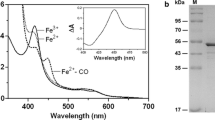Abstract
CYP199A2, a bacterial P450 monooxygenase from Rhodopseudomonas palustris, was previously reported to oxidize 2-naphthoic acid and 4-ethylbenzoic acid. In this study, we examined the substrate specificity and regioselectivity of CYP199A2 towards indole- and quinolinecarboxylic acids. The CYP199A2 gene was coexpressed with palustrisredoxin gene from R. palustris and putidaredoxin reductase gene from Pseudomonas putida to provide the redox partners of CYP199A2 in Escherichia coli. Following whole-cell assays, reaction products were identified by mass spectrometry and NMR spectroscopy. CYP199A2 did not exhibit any activity towards indole and indole-3-carboxylic acid, whereas this enzyme oxidized indole-2-carboxylic acid, indole-5-carboxylic acid, and indole-6-carboxylic acid. Indole-2-carboxylic acid was converted to 5- and 6-hydroxyindole-2-carboxylic acids at a ratio of 59:41. In contrast, the indole-6-carboxylic acid oxidation generated only one product, 2-indolinone-6-carboxylic acid, at a rate of 130 mol (mol P450)−1 min−1. Furthermore, CYP199A2 also oxidized quinoline-6-carboxylic acid, although this enzyme did not exhibit any activity towards quinoline and its derivatives with a carboxyl group at the C-2, C-3, or C-4 positions. The oxidation product of quinoline-6-carboxylic acid was identified to be 3-hydroxyquinoline-6-carboxylic acid, which was a novel compound. These results suggest that CYP199A2 may be a valuable biocatalyst for the regioselective oxidation of various aromatic carboxylic acids.




Similar content being viewed by others
References
Appel D, Lutz-Wahl S, Fischer P, Schwaneberg U, Schmid RD (2001) A P450 BM-3 mutant hydroxylates alkanes, cycloalkanes, arenes and heteroarenes. J Biotechnol 88:167–171
Bell SG, Hoskins N, Xu F, Caprotti D, Rao Z, Wong LL (2006) Cytochrome P450 enzymes from the metabolically diverse bacterium Rhodopseudomonas palustris. Biochem Biophys Res Commun 342:191–196
Bell SG, Xu F, Forward I, Bartlam M, Rao Z, Wong LL (2008) Crystal structure of CYP199A2, a para-substituted benzoic acid oxidizing cytochrome P450 from Rhodopseudomonas palustris. J Mol Biol 383:561–574
Bernhardt R (2006) Cytochromes P450 as versatile biocatalysts. J Biotechnol 124:128–145
Bradford MM (1976) A rapid and sensitive method for the quantitation of microgram quantities of protein utilizing the principle of protein-dye binding. Anal Biochem 72:248–254
Celik A, Speight RE, Turner NJ (2005) Identification of broad specificity P450CAM variants by primary screening against indole as substrate. Chem Commun 29:3652–3654
Chefson A, Auclair K (2006) Progress towards the easier use of P450 enzymes. Mol Biosyst 2:462–469
Dowers TS, Rock DA, Rock DA, Perkins BN, Jones JP (2004) An analysis of the regioselectivity of aromatic hydroxylation and N-oxygenation by cytochrome P450 enzymes. Drug Metab Dispos 32:328–332
Furuya T, Kino K (2009) Discovery of 2-naphthoic acid monooxygenases by genome mining and their use as biocatalysts. ChemSusChem 2:645–649
Furuya T, Nishi T, Shibata D, Suzuki H, Ohta D, Kino K (2008) Characterization of orphan monooxygenases by rapid substrate screening using FT-ICR mass spectrometry. Chem Biol 15:563–572
Gillam EM, Notley LM, Cai H, De Voss JJ, Guengerich FP (2000) Oxidation of indole by cytochrome P450 enzymes. Biochemistry 39:13817–13824
Kiener A (1995) Biosynthesis of functionalized aromatic N-heterocycles. Chemtech 25:31–35
Li QS, Schwaneberg U, Fischer P, Schmid RD (2000) Directed evolution of the fatty-acid hydroxylase P450 BM-3 into an indole-hydroxylating catalyst. Chemistry 6:1531–1536
Liu Y, Zhao Y, Zhai X, Feng X, Wang J, Gong P (2008) Synthesis and anti-hepatitis B virus evaluation of novel ethyl 6-hydroxyquinoline-3-carboxylates in vitro. Bioorg Med Chem 16:6522–6527
Michael JP (2008) Quinoline, quinazoline and acridone alkaloids. Nat Prod Rep 25:166–187
Omura T, Sato R (1964) The carbon monoxide-binding pigment of liver microsomes. I. Evidence for its hemoprotein nature. J Biol Chem 239:2370–2378
Petersen M, Kiener A (1999) Biocatalysis. Green Chem 1:99–106
Pierson PD, Fettes A, Freichel C, Gatti-McArthur S, Hertel C, Huwyler J, Mohr P, Nakagawa T, Nettekoven M, Plancher JM, Raab S, Richter H, Roche O, Rodríguez Sarmiento RM, Schmitt M, Schuler F, Takahashi T, Taylor S, Ullmer C, Wiegand R (2009) 5-Hydroxyindole-2-carboxylic acid amides: novel histamine-3 receptor inverse agonists for the treatment of obesity. J Med Chem 52:3855–3868
Reigh G, McMahon H, Ishizaki M, Ohara T, Shimane K, Esumi Y, Green C, Tyson C, Ninomiya S (1996) Cytochrome P450 species involved in the metabolism of quinoline. Carcinogenesis 17:1989–1996
Roth GJ, Heckel A, Colbatzky F, Handschuh S, Kley J, Lehmann-Lintz T, Lotz R, Tontsch-Grunt U, Walter R, Hilberg F (2009) Design, synthesis, and evaluation of indolinones as triple angiokinase inhibitors and the discovery of a highly specific 6-methoxycarbonyl-substituted indolinone (BIBF 1120). J Med Chem 52:4466–4480
Schalk M, Batard Y, Seyer A, Nedelkina S, Durst F, Werck-Reichhart D (1997) Design of fluorescent substrates and potent inhibitors of CYP73As, P450s that catalyze 4-hydroxylation of cinnamic acid in higher plants. Biochemistry 36:15253–15261
Schoch GA, Attias R, Le Ret M, Werck-Reichhart D (2003) Key substrate recognition residues in the active site of a plant cytochrome P450, CYP73A1. Homology guided site-directed mutagenesis. Eur J Biochem 270:3684–3695
Sugden JK, Yoloye TO (1978) Medicinal applications of indole derivatives. Pharm Acta Helv 53:65–92
Ullrich R, Hofrichter M (2007) Enzymatic hydroxylation of aromatic compounds. Cell Mol Life Sci 64:271–293
Urlacher VB, Eiben S (2006) Cytochrome P450 monooxygenases: perspectives for synthetic application. Trends Biotechnol 24:324–330
Yoshida T, Nagasawa T (2000) Enzymatic functionalization of aromatic N-heterocycles: hydroxylation and carboxylation. J Biosci Bioeng 89:111–118
Author information
Authors and Affiliations
Corresponding author
Electronic supplementary material
Below is the link to the electronic supplementary material.
Table S1
NMR data for 5-hydroxyindole-2-carboxylic acid (DOC 35.5 kb)
Table S2
NMR data for 6-hydroxyindole-2-carboxylic acid (DOC 35.5 kb)
Table S3
NMR data for 2-indolinone-6-carboxylic acid (DOC 24.5 kb)
Table S4
NMR data for 3-hydroxyquinoline-6-carboxylic acid (DOC 27 kb)
Rights and permissions
About this article
Cite this article
Furuya, T., Kino, K. Regioselective oxidation of indole- and quinolinecarboxylic acids by cytochrome P450 CYP199A2. Appl Microbiol Biotechnol 85, 1861–1868 (2010). https://doi.org/10.1007/s00253-009-2207-1
Received:
Revised:
Accepted:
Published:
Issue Date:
DOI: https://doi.org/10.1007/s00253-009-2207-1



